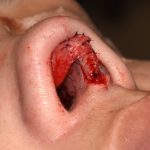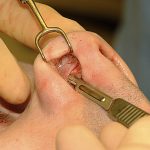Rhinoplasty is a complex array of cartilage rearrangement and bone manipulation that takes place underneath or behind the skin that covers the nose. Getting to the structures of the nose can be done be either working underneath the skin or seeing the structures directly by lifting off the skin. These two approaches are done by using incisions placed inside the nose (endonasal approaches) or via incisions placed inside the nose combined with incisions placed outside the nostrils (external approach), on the columella. (strip of skin between the nostrils)

The endonasal or closed rhinoplasty has numerous real advantages including a decreased need for surgical dissection, reduced postoperative swelling, less operative time, absence of a columellar scar, and a quicker return to an unoperated appearance. Theoretical but appealing advantages of its use include the ability to change the nose without talking it apart and one can see how the tip of the nose changes with cartilage manipulation as the skin is still intact.
In theory, an experienced rhinoplasty surgeon can use either an endonasal or an external rhinoplasty approach, based on what is best for the patient’s nasal anatomy. In reality, the difficulty of rhinoplasty surgery and the high level of patient scrutiny make the open approach a more comfortable one to get the most assured result. But the open approach is not perfect with more extensive scarring and sometimes unpredicted distortions of the nose with scar contracture in some cases.

The trend towards more closed rhinoplasties, however, will incorporate what has been learned from open procedures¦..that of support and increasing structural integrity. Endonasal rhinoplasty has long been considered a reductive operation in which nose structures were removed. This left many noses over reduced and in need of difficult secondary revisions. Thus was born the open rhinoplasty, where the use of cartilage grafting for support became necessary. When such principles are applied to this new generation of endonasal rhinoplasty, more predictable and better long-term results will be obtained.
Endonasal or closed rhinoplasty has the advantages of a shorter operative time and less swelling after surgery. In the properly selected nose (not a revision case), we will see endonasal rhinoplasty re-emerge to once again become commonplace in many primary nasal deformities.
Barry L. Eppley, M.D., D.M.D.
Indianapolis, Indiana


